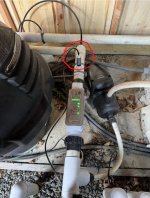Not pool in signature:
I'm involved in this pool as a back up to the customer to be reassured pb isn't doing anything non recommended. This pool and equipment is still under warranty so the po doesn't want to abandon them yet with Easytouch/ Intellichem. Not a fan of the intellichem system as I have many without it running perfectly well.ORP sensors is a non stop cleaning or change out issue. I find the Intellichem is constantly malfunctioning and causing non stop call outs to the pb and they're always looking for items to bill, for instance, I laid down the law of the land that nothing gets added to the water without my pre check. In one scenario they brought some gallon jug to lower the FC which was about 9-10 at the time and I said nothing doing. 10 fc isn't high and if it's high it'll come down without adding that junk.
FC which was about 9-10 at the time and I said nothing doing. 10 fc isn't high and if it's high it'll come down without adding that junk.
Rant over, now the question. Pool pad is having an enclosure being built as this pool stays open all year and is also heated to the sky with the auto cover. I was doing my inspection yesterday on the ongoing work and saw something that to me may not be right. The MA injection line is plumbed right before the salt cell and that can't be correct. The first cell lasted about one year and was under warranty but something tells me now the cause may be due to the constant diluted MA passing through the plates. I'm I onto something here?
I'm involved in this pool as a back up to the customer to be reassured pb isn't doing anything non recommended. This pool and equipment is still under warranty so the po doesn't want to abandon them yet with Easytouch/ Intellichem. Not a fan of the intellichem system as I have many without it running perfectly well.ORP sensors is a non stop cleaning or change out issue. I find the Intellichem is constantly malfunctioning and causing non stop call outs to the pb and they're always looking for items to bill, for instance, I laid down the law of the land that nothing gets added to the water without my pre check. In one scenario they brought some gallon jug to lower the
 FC which was about 9-10 at the time and I said nothing doing. 10 fc isn't high and if it's high it'll come down without adding that junk.
FC which was about 9-10 at the time and I said nothing doing. 10 fc isn't high and if it's high it'll come down without adding that junk.Rant over, now the question. Pool pad is having an enclosure being built as this pool stays open all year and is also heated to the sky with the auto cover. I was doing my inspection yesterday on the ongoing work and saw something that to me may not be right. The MA injection line is plumbed right before the salt cell and that can't be correct. The first cell lasted about one year and was under warranty but something tells me now the cause may be due to the constant diluted MA passing through the plates. I'm I onto something here?


